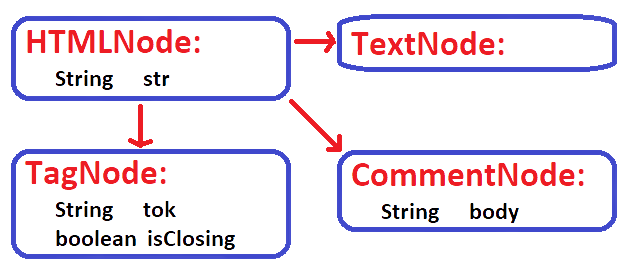Package Torello.HTML
Class TextNode
- java.lang.Object
-
- Torello.HTML.HTMLNode
-
- Torello.HTML.TextNode
-
- All Implemented Interfaces:
java.io.Serializable,java.lang.CharSequence,java.lang.Cloneable,java.lang.Comparable<TextNode>
public final class TextNode extends HTMLNode implements java.lang.CharSequence, java.io.Serializable, java.lang.Cloneable, java.lang.Comparable<TextNode>
Concrete HTMLNode SubClasses:
The three inherited classes ofabstract class HTMLNodeare very light-weight, and contain some amount ofpublicmethods, but do not have heavy internal-state (either static, or non-static). Below is a list of the internal field's that are added to each of the three instantiations of the ancestorHTMLNode class:class TagNodeadds a fieldpublic final boolean isClosing- which tells a user if this tag has a forward-slash immediately following the '<' (less-than symbol) at character position 2. This is how one identifies a 'closing-version' of the element, for instance: '</DIV>' and '</SPAN>' would both have theirpublic final boolean isClosingfields set to TRUE. There is also apublic final String tokfield added to instances ofTagNodethat identify what html element the TagNode represents. For example an HTML Element such as:<A HREF="http://My.URL.com" TARGET=_blank>, would have it'sString 'tok'field set to'a'
class TextNodethis inherited class fromclass HTMLNodedoes not add any internal state at all. It has the exact same internally-maintained fields as its parent-class. Thepublic final String strfield merely states what text this text-node actually represents.
class CommentNodefor searching-purposes, and ease-of-use,class CommentNode, which is the third and final class to inheritHTMLNodekeeps one extra internal-field, which ispublic final String body. This field is a redundant, duplicate, of the internal stringpublic final String str- which is inherited from the HTML Node class. The subtle difference is that, since comment nodes represent the HTML<!-- and -->symbols, the'body'of the comment sometimes needs to be searched, quickly. Thepublic final String bodyleaves off these leading and ending comment delimiter symbols:<!-- and -->
Represents document text, and is one of only three HTML Element Classes provided by the Java HTML Library Tool, and also oneof the three classes that can be generated by the HTML Parser.
ClassTextNodeis a subclass ofabstractclassHTMLNode, add does not add any methods or fields to the class-structure at all.
IMPORTANT:
Text that is found between both the HTML<SCRIPT> ...</SCRIPT>, and also the HTML<STYLE> ... </STYLE>is simply saved as an instance of classTextNode. The real rationale behind this comes by way of the fact that these HTML Parse, Search, Update and Scrape classes are not capable executing script, yet...
As such, there is no parse performed on CSS, Java-Script, jQuery, or any other of the myriad scripting languages often found inside of HTML documents. Rather than creating any number of various and sundry "partial parses" or "attempted parses," this text is just left as an instance of classTextNode, but of course whatever HTML<SCRIPT>or<STYLE>elements surrounding this text node shall of course be easily found.
Inheritance Tree Diagram:
Below is the inheritance diagram (with fields) of the three concrete-classes that extend theabstractclassHTMLNode:
- See Also:
HTMLNode,TagNode,CommentNode, Serialized Form
Hi-Lited Source-Code:- View Here: Torello/HTML/TextNode.java
- Open New Browser-Tab: Torello/HTML/TextNode.java
File Size: 3,994 Bytes Line Count: 104 '\n' Characters Found
-
-
Field Summary
Serializable ID Modifier and Type Field static longserialVersionUIDAlternate java.util.Comparator Modifier and Type Field static Comparator<TextNode>comp2
-
Constructor Summary
Constructors Constructor Description TextNode(String s)Constructs a newTextNodewith internal fieldString strequal to parameter's'
-
Method Summary
Methods: interface java.lang.Cloneable Modifier and Type Method TextNodeclone()Methods: interface java.lang.Comparable Modifier and Type Method intcompareTo(TextNode tn)'instanceof' Operator Replacement Methods Modifier and Type Method TextNodeifTextNode()booleanisTextNode()-
Methods inherited from class Torello.HTML.HTMLNode
asCommentNode, asTagNode, asTextNode, charAt, equals, hashCode, ifCommentNode, ifTagNode, isCommentNode, isOpenTag, isOpenTagPWA, isTagNode, length, openTag, openTagPWA, subSequence, toString
-
-
-
-
Field Detail
-
serialVersionUID
public static final long serialVersionUID
This fulfils the SerialVersion UID requirement for all classes that implement Java'sinterface java.io.Serializable. Using theSerializableImplementation offered by java is very easy, and can make saving program state when debugging a lot easier. It can also be used in place of more complicated systems like "hibernate" to store data as well.- See Also:
- Constant Field Values
- Code:
- Exact Field Declaration Expression:
public static final long serialVersionUID = 1;
-
comp2
public static final java.util.Comparator<TextNode> comp2
This is an "alternative Comparitor" that can be used for sorting instances of this class. It should work with theCollections.sort(List, Comparator)method in the standard JDK packagejava.util.*;
NOTE: This version utilizes the standard JDKString.compareToIgnoreCase(String)method.- See Also:
HTMLNode.str- Code:
- Exact Field Declaration Expression:
public static final Comparator<TextNode> comp2 = (TextNode txn1, TextNode txn2) -> txn1.str.compareToIgnoreCase(txn2.str);
-
-
Constructor Detail
-
TextNode
public TextNode(java.lang.String s)
Constructs a newTextNodewith internal fieldString strequal to parameter's'- Parameters:
s- Any valid JavaStringmay be passed here.- Code:
- Exact Constructor Body:
super(s);
-
-
Method Detail
-
isTextNode
public final boolean isTextNode()
This method identifies that'this'instance of (abstract parent-class)HTMLNodeis, indeed, an instance of sub-classTextNode.
Final Method:
This method is final, and cannot be modified by sub-classes.- Overrides:
isTextNodein classHTMLNode- Returns:
- This method shall always return
TRUEIt overrides the parent-classHTMLNodemethodisTextNode(), which always returnsFALSE. - See Also:
isTextNode()- Code:
- Exact Method Body:
return true;
-
ifTextNode
public final TextNode ifTextNode()
This method identifies that'this'instance of (abstract parent-class)HTMLNodeis, indeed, an instance of sub-classTextNode.
Final Method:
This method is final, and cannot be modified by sub-classes.- Overrides:
ifTextNodein classHTMLNode- Returns:
'this'reference. This method can be used inside loops for improving the readability of loop-condition expressions. See example below:
Example:
TextNode t; for (HTMLNode n : myHTMLVector) if ((t = n.ifTextNode()) != null) System.out.println("Text-Node Contains: " + t.str);
This method-version overrides the parent-class-version, which always returns null. This method is not overriden by otherHTMLNodesub-classes.- See Also:
ifTextNode()- Code:
- Exact Method Body:
return this;
-
clone
-
compareTo
public int compareTo(TextNode tn)
Java'sinterface Comparable<T>requirements. This does a very simple comparison using the underlying fieldfinal String strthat all Text's contain.- Specified by:
compareToin interfacejava.lang.Comparable<TextNode>- Parameters:
tn- Any otherTextNodeto be compared to'this' TextNode- Returns:
- An integer that fulfils Java's
interface Comparable<T> public boolean compareTo(T t)method requirements. - Code:
- Exact Method Body:
return this.str.compareTo(tn.str);
-
-